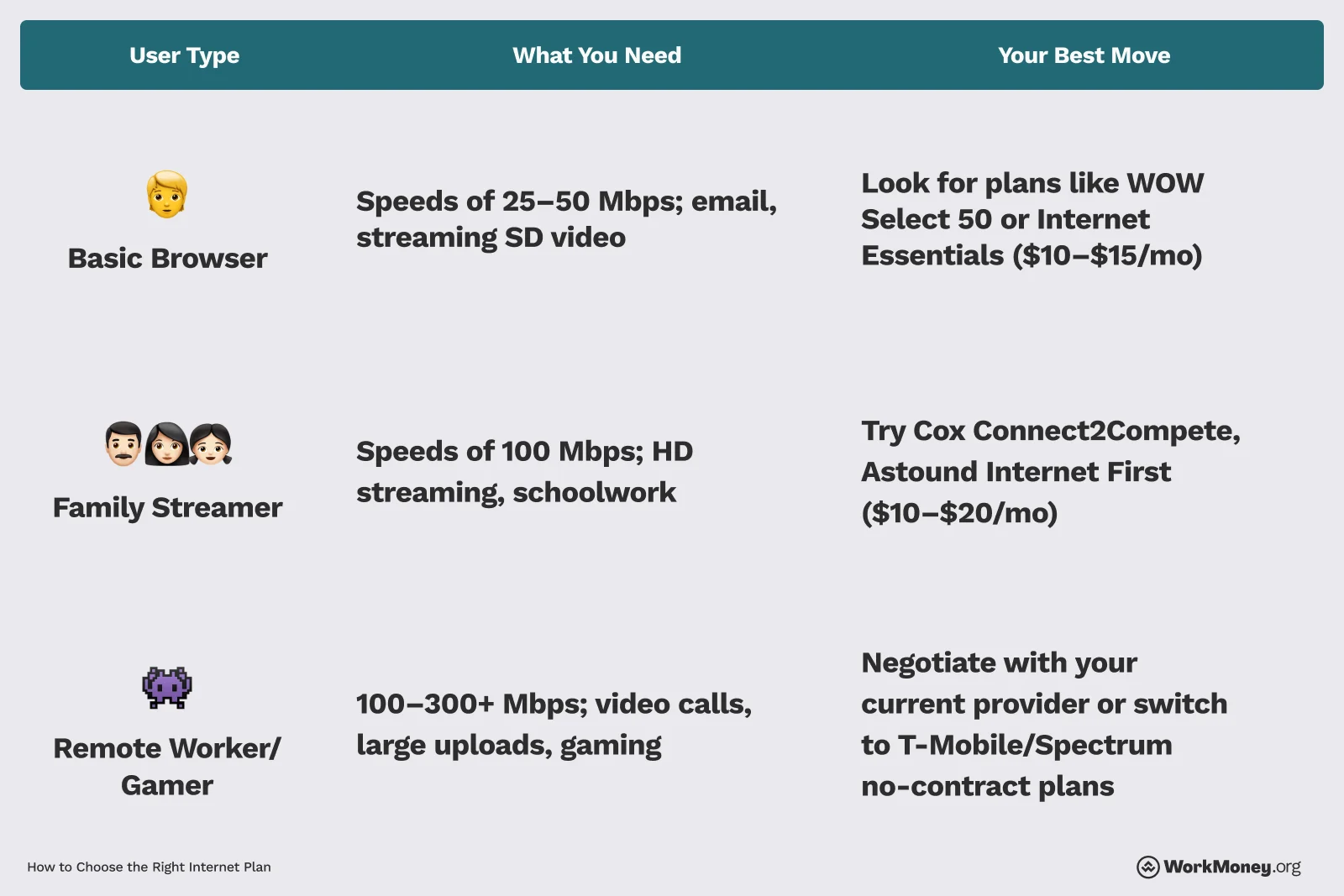Cheapest Ways to Get Home Wi-Fi
You don’t need to overpay for Wi-Fi. Here’s how to get reliable internet at home for $30 or less—even without the Affordable Connectivity Program

Internet is as essential as power or water these days, but it can be surprisingly expensive. Prices keep rising, hidden fees sneak in, and contracts lock you into more than you need.
When the Affordable Connectivity Program ended in June 2024, roughly 5 million households lost vital internet access. But the good news? There are still plenty of ways to stay connected without breaking the bank. Many Americans qualify for internet plans that cost $30 or less. The catch? Providers rarely advertise them, and sneaky rental fees or contracts can quietly double your bill. WorkMoney exists to help you save on this essential expense.
Whether you’re on a tight budget or just tired of overpaying, this guide will show you how to get reliable Wi-Fi for less.

1. Free or Nearly-Free Internet via Public Programs
Best for: Low-income households
If you're part of a lower-income household, you may be able to pay little to nothing for internet access. Here’s how.
Step 1: Apply for Lifeline
This federal benefit reduces your monthly internet bill by $9–$30. You may qualify if you:
Earn below 135% of the federal poverty level
Receive SNAP, Medicaid, or other government assistance
Lifeline can get you a significantly reduced internet bill.
Step 2: Use Everyone On
This nonprofit helps households earning under $49,000 find:
Discounted internet plans
Low-cost computers
WorkMoney Tip: WorkMoney members who combine Lifeline and Everyone On typically pay around $12/month for 30 Mbps service—enough for streaming, remote work, and online learning.
Step 3: Use Free Public Hotspots
When needed, you can supplement home internet with public Wi-Fi from:
Libraries
Schools
Community centers
Coffee shops
2. Cut Your Bill Without Switching Providers
Best for: Renters or anyone stuck in a contract
Buy your own modem and router
Stop paying $15/month in rental fees when you can buy equipment for under $100. Not only can it pay for itself in just a few months, but it may also boost your internet performance. It’s a simple one-time investment that can save you hundreds over time.Ask about hidden discount plans
Many internet providers offer low-cost or income-based plans, but they rarely advertise them. Call your current provider and ask: “I’m trying to reduce my internet bill. Do you offer any discounted or income-based plans I might qualify for?”
You might be surprised by what’s available. Some providers offering low-cost options include:
- Astound Broadband: Internet First: Up to 100Mbps for $10–$20/month, unlimited data, no contract.
- Cox Communications: Connect2Compete: 100Mbps for $10/month (families); ConnectAssist: 100Mbps for $30/month (individuals). Free equipment and installation.
- Starry Internet: $15/month for 30Mbps, no data caps, no equipment fees (availability varies).
- WOW Internet: Internet Select 50: 30Mbps for $10/month for qualifying families. Includes free equipment and self-installation.
- Xfinity: Internet Essentials: 75Mbps for $15/month or 100Mbps for $30/month in select areas.
3. Be Savvy
Best for: Those who don’t qualify for assistance but want to save
Not eligible for low-income programs? You can still lower your bill with a few smart moves:
Stick to Internet-Only Plans
Bundles with cable or landlines often cost more than they’re worth. Choose a stand-alone internet with no contracts or hidden add-ons. Many providers like Spectrum, Xfinity, and T-Mobile offer basic high-speed plans that cover everyday needs without the fluff.Review and Renegotiate Annually
Providers typically hike prices after the first year. Mark your calendar to review your plan each year, and don’t be afraid to call and say you’re considering switching—they may offer a discount or promo to keep your business.Use What You Already Have
An old phone or tablet with a mobile plan can be turned into a backup hotspot in emergencies. It’s a simple way to stay online without extra costs.
How to Choose the Right Internet Plan
Start by figuring out how much speed you actually need—higher speeds usually mean higher prices. If you mostly browse or stream in HD, 50–100 Mbps is plenty. Larger households or gamers may need more. Skip bundles and only pay for what you use. Always check for hidden fees like equipment rentals, and consider no-contract or low-income plans if you qualify.
User Type | What You Need | Your Best Move |
|---|---|---|
Basic Browser (1–2 users) | Speeds of 25–50 Mbps; email, streaming SD video | Look for plans like WOW Select 50 or Internet Essentials ($10–$15/mo) |
Family Streamer (3–5 users) | Speeds of 100 Mbps; HD streaming, schoolwork | Try Cox Connect2Compete, Astound Internet First ($10–$20/mo) |
Remote Worker/Gamer (4+ users) | 100–300+ Mbps; video calls, large uploads, gaming | Negotiate with your current provider or switch to T-Mobile/Spectrum no-contract plans |
Common Mistakes to Avoid
Renting a modem instead of buying your own
Assuming you make too much money to qualify for aid
Never negotiating your bill
Ignoring the fine print (watch for promo expirations and automatic fee increases)
Final Tips to Stay Connected for Less
Getting online shouldn’t break the bank. By checking your plan annually, negotiating rates, and making sure you’re only paying for the speed and services you actually need, you can avoid overpaying. Don’t forget to take advantage of any discounts or benefits you’re eligible for—even a quick call can unlock serious savings. With a little effort, staying connected can be both affordable and reliable.
About the Author

Brett Holzhauer
Brett Holzhauer is a Certified Personal Finance Counselor (CPFC) who has reported for outlets like CNBC Select, Forbes Advisor, LendingTree, UpgradedPoints, MoneyGeek and more throughout his career. He is an alum of the Walter Cronkite School of Journalism at Arizona State. When he is not reporting, Brett is likely watching college football or traveling.
